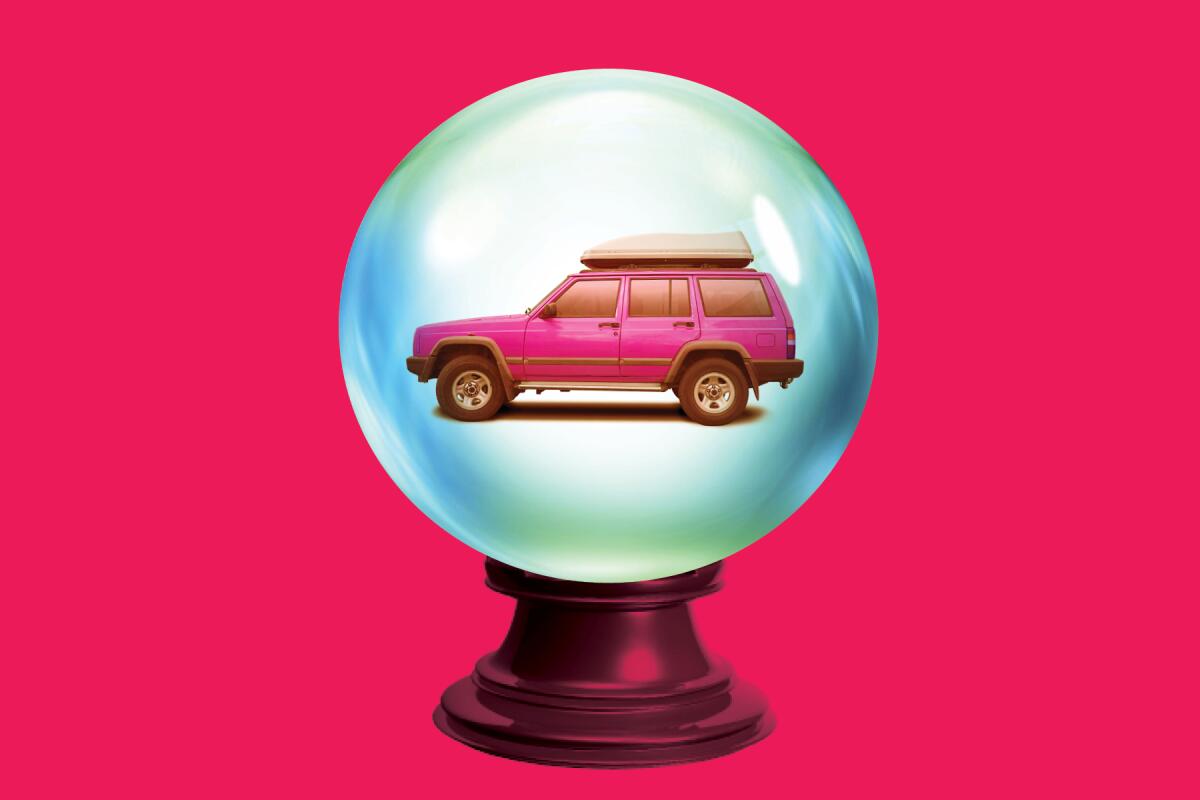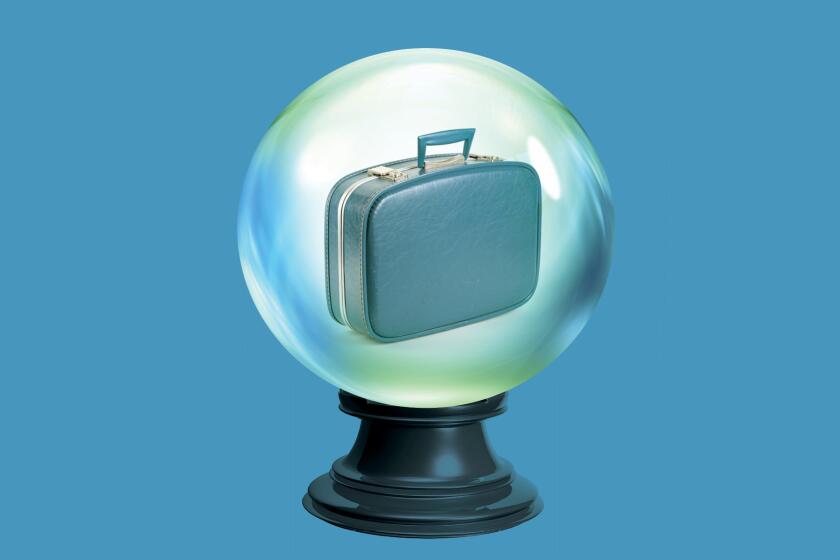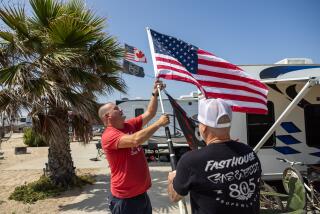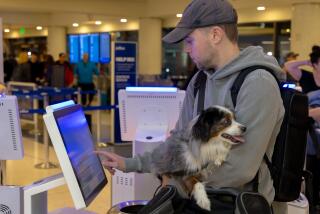After coronavirus: Your next road trip may look like this

- Share via
Few things having to do with travel will be unchanged in the post-coronavirus world, but of all the ways we travel, the all-American road trip may be least affected — at least, from a regulatory standpoint. No one will tell you to wear a mask or take your temperature or demand blood work before you hit the road this summer.
But questions abound about this American institution, including whether it’s safe — at least, safer than airline travel.
Here’s what your road trip of the future may look like:
Is driving safer than flying?
People are increasingly looking at car trips for their vacation plans, according to data from MMGY Travel Intelligence in partnership with the U.S. Travel Assn. In a survey taken April 17-22, 47% of respondents said they would be more likely to travel by car, an increase from 35% in data collected April 4-11.
For all travelers, safety is a priority, and many are asking whether driving is safer than flying these days.
Your next flight probably won’t be much like your last one. It may cost more, it may be emptier, it may include a ‘sky janitor.’ And forget snacks.
In terms of the coronavirus, probably, said Dr. Robert Winters, a Southern California infectious disease specialist.
“If traveling with others in a car, one would assume you know the person that is sitting next to you and you know their health status,” Winters said in an email.
“Car travel has to be safer than airline travel when you factor in controlled boarding/exiting processes, number of people on the airplane, unknown health status of people on the flight, uncooperative children sitting near you, etc.”
In terms of crashes, planes are safer. In 2019, about 39,000 people died in automobile accidents, according to the National Safety Council. Airplane crashes caused 257 deaths that year, according to To70’s aviation review.
Before you leave
•Do your car’s regular pre-trip check — tires, especially — that AAA recommends, noting that getting stranded may have greater consequences because of reduced service.
•Check conditions at your destination to ensure that you’re not hitting a hot spot. The Centers for Disease Control and Prevention offers a map that shows hot spots and provides data at bit.ly/coronavirushotspots
•Double-check whether the state you’re heading to has self-quarantine in effect. Although federal law cannot bar you from traveling to a state, local authorities can require self-quarantine for as long as 14 days. To check whether the state you’re planning to visit has such a regulation, call the state health authority from a list provided by the CDC: bit.ly/statehealthdepartments.
•Pack masks and gloves for all riders, Winters said, and make provisions for hand washing/sanitizer (BYOSS — bring your own soap and sanitizer). Disinfectant wipes are a must.
•Check in with your healthcare provider, AAA suggests, especially if your passengers are older or have medical issues.
•Pack a cooler with drinks and snacks, including high-protein goodies that will not go bad, to reduce the number of stops.
•Clean your car. About a third of drivers clean the inside of their car only about once a year, said Sheryl Connelly, a futurist who studies global consumer trends for Ford Motor Co., adding that the steering wheel is generally four times dirtier than a restroom. Besides that high-touch point, clean safety belts, door handles and even the fob you use to start the car. In the future, cars may have anti-microbial surfaces, she said. The CDC offers suggestions on how to sanitize your home, many of which are applicable to the car: bit.ly/CDCclisinfecting. (Bleach or cleaning solutions with bleaching agents should not be used on surfaces, such as carpeting, that are not colorfast.)
National parks are opening the way they closed, each in its own way.
•Pack plenty of charging cords and perhaps external batteries for electronic devices. If your navigation system contains emergency calling, enable that as well, Connelly said.
•Plan like a demon. You don’t want to wing it, especially for hotels, restaurants or rest areas. And don’t rely on websites, said Bill Clevlen, a travel broadcaster and writer who travels to 50 or 60 destinations a year as he helps travelers “rediscover” America.
“If you’re planning on making a pit stop or two along your route, call ... to make sure the restaurant or rest area is actually going to be open,” he said in an email. “Some will have shut down for good or will have had hours change. This is particularly true in places that have relied solely on ‘travel traffic’ away from more populated areas.”
•Read the fine print. Understand the lodging’s cancellation rules. “Make sure the hotel or rental property you book has an iron-clad refund policy,” Clevlen said. “Major hotels seem to have been very reasonable, but still ask.” Booking directly with the hotel may spare you some back and forth with a third-party site if something goes wrong, he said.
And now, for some good news
In a year in which good news has been rare, here’s some: You’ll pay significantly less for gasoline. Small fluctuations in gas prices usually make little difference in your trip costs, but this year is an exception.
In the pandemic aftermath, what will hotels do differently?
Let’s say you’re driving to San Francisco and back. You fill up in L.A. for the trip north at an average of $2.83 a gallon and in San Francisco at $2.99 a gallon for the trip home in a car that averages 30 mpg. This year, you’ll save more than $33 in gas, based on year-ago prices in both locations that topped $4 a gallon, according to the AAA Gas Prices report.
Will low prices continue? Definite maybe. Prices increased by a penny a gallon on May 1. As long as there is an oversupply of oil, as has been the case in recent weeks, your outlay for your miles on the L.A.-San Francisco trip may continue to total $75 or less.
One final, delicate topic: the rest stop
Calling ahead to be sure your favorite rest stop is open is a good idea. You’ll also want to take an occasional break and avoid driving drowsy, which accounted for more than 100,000 accidents in 2019, according to the National Safety Council. Further, the CDC notes that many thousands of Americans report “short sleep,” that is, getting less than seven hours a night.
If you look at the CDC’s map for California, it’s a wonder that Southern Californians can keep their eyes open: The stats show that people in L.A., Riverside and San Diego counties, among others, show the highest rate of sleep deprivation. Add to that the stress of recent events that’s keeping us awake, and it’s a formula for falling asleep at the wheel.
So by all means, stop. Pull over. Take a snooze. But before using the restroom, consider the grunge factors. You need a restroom with soap and hot water, two forceful combatants against the coronavirus.
Create a restroom break kit for each person traveling with you: small bars of soap, paper towels (for drying and avoiding high-touch handles), travel-size packs of toilet seat covers; include hand sanitizer and wipes for when soap and water are not available.
If you are at a gas station, consider the restroom break after you pump gas, and wash hands before and after. (If only pumping gas, gloves are a good idea. Dispose in the nearby trash containers, not on the ground.)
Overreacting? Possibly. But in this age of the coronavirus, we must act as though our life depends on the precautions we take.
More to Read
Sign up for The Wild
We’ll help you find the best places to hike, bike and run, as well as the perfect silent spots for meditation and yoga.
You may occasionally receive promotional content from the Los Angeles Times.









